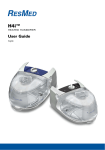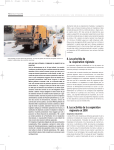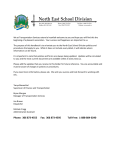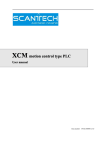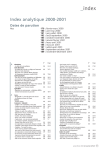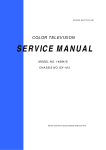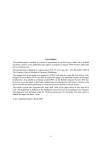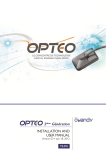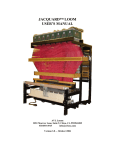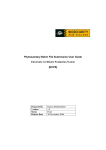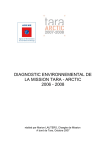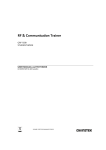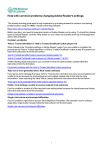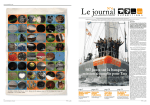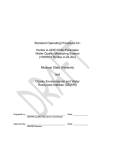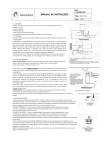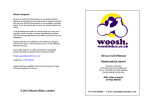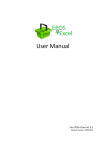Download Notice 827 - Doncaster Chamber
Transcript
Notice 827 European Community Preferences: export procedures April 2012 Foreword This notice cancels and replaces Notice 827 (January 2007). 1. Introduction 1.1 What is this notice about? It explains how you, as an exporter, can help your customers in some countries to import your goods more cheaply under “preference”. These countries are listed in paragraph 1.4. (N.B. These rules are reciprocal, that is, they will also apply to goods being imported into the EU under preference). The rules of origin are shown in Notices 828, 830 (wef 01/01/11), 832 and South Korea Guide (wef 01/07/11) Notice 829 has temporarily been withdrawn. You can access details of any changes to this notice since March 2012 either on our Internet website at www.hmrc.gov.uk or by phoning the VAT, Excise and Customs Helpline on 0845 010 9000. This notice and others mentioned are available on our website. 1.2 What’s changed This notice has been amended to take account of the new reciprocal preferential trade agreements between the EU and the following countries: Serbia, Montenegro and Bosnia-Herzegovina. It includes reference to the New Notice 830: Tariff Preference: New GSP Rules of origin (wef 01/01/11) and the South Korea Guide (wef 01/07/11) and also includes some minor textual amendments to the notice. It links to information on the ACP countries that are part of the MAR agreement and to information on the Cariforum States. It includes the name change for the Department for Business Innovation & Skills (BIS) from the Department for Regulatory Reform (BERR) and also the address change for the Association of British Chambers of Commerce. It includes the current details for applying to be an UK or EC Wide approved exporter and provides the address to forward INF4 Information Certificates. It updates the autonomous countries that the EU grants a feature that is known as Donor country content at section 9 of the notice. Page 1 of 53 Notice 827 European Community Preferences: export procedures April 2012 It updates the scope and usuage of preference documentation at section 20 of this notice including the current value limits and takes account of the change to the value limits for exporting low-value goods. The information on appeals shown at the end of the notice has been updated. Any changes to this notice after March 2012 may be accessed on our website at hmrc.gov.uk or by phoning the Helpline on Tel: 0845 010 9000 1.3 What is “preference”? “Preference” means that your customer abroad may pay a lower or “nil” rate of import customs duty on your goods. 1.4 How do my goods qualify for preference? Your goods must satisfy the rules of origin as set out in: Notice 828 Tariff Preferences: Rules of Origin for ACP (MAR), Algeria, Albania, Andorra, Bosnia/Herzegovina, Cariforum States Ceuta, Chile, Croatia, Egypt, Faroe Islands, Iceland, Israel, Jordan, Lebanon, Liechtenstein, Macedonia, Melilla, Moldova, Montenegro, Kosovo, Morocco, Norway, OCT, Serbia, South Africa, South Korea, Switzerland,Tunisia, Turkey, and the Territories of the West Bank and Gaza Strip. • Notice 830 New GSP Rules of origin (wef 1/1/11) • Notice 832 Tariff Preferences: Rules of Origin for Mexico. • South Korea Guide:exceptions to the rules of origin in the EU South Korea Agreement And also the rules for: • Transportation - see paragraph 2.3 and • Export relief - see paragraph 2.4 Section 4 of this Notice provides information about the additional requirements that must be met in order for goods to be exported under the Pan-Euro-Med cumulation arrangements. 1.5 Which countries give preference? The preference-giving countries are: The Pan-Euro Mediterranean countries of: • Algeria, Morocco and Tunisia (Maghreb group) Page 2 of 53 Notice 827 European Community Preferences: export procedures April 2012 • Egypt, Jordan, Lebanon and Syria (Mashraq group) • Iceland, Norway, Switzerland and Liechenstein [European Free Trade Association (EFTA)] • Faroe Islands • West Bank Gaza • Israel • Turkey (for agricultural and coal and steel products only – all other products are covered by Customs Union arrangements between the EU and Turkey); Other countries • Albania • Andorra • Bosnia-Herzegovinia • Ceuta & Melilla • Croatia • Macedonia • Mexico • Montenegro • Serbia • South Africa. • South Korea (wef 1/7/11) While the following countries do not give preference, products originating in the EU in accordance with preferential rules of origin can be exported to them under Donor Country content arrangements- See paragraph 9.6: • Kosovo and Moldova • Some of the African, Caribbean and Pacific States (ACP), and Overseas Countries and Territories (OCT) details of which may be obtained from the Department for Business Innovation & Skills (BIS) formerly the Department for Business Enterprise and Regulatory Reform (BERR) (see paragraph 1.5). A full list of these countries can be found in Volume 1 Part 7 of the Tariff Page 3 of 53 Notice 827 European Community Preferences: export procedures April 2012 • GSP (Generalised System of Preferences) Countries - see Notice 826 and 830 for further details 1.6 Who can tell me more about preference given abroad? If you want to know about… You should ask either… • Which goods are eligible for preference; • Preference rates of duty abroad; or • Your overseas customer or the Department for Business Innovation and Skills (BIS) Quota limits You can contact BIS at: 1 Victoria Street, London, SW1 0ET Tel: 020 7215 5000. When contacting BIS specify the country to which you intend to export. 1.7 What documents must I use to allow my customer to claim preference? Information about the required documentation can be found in Sections 3 and 5. The respective value limits for the use of preference documents are listed at Section 20 of this Notice. You do not have to use these documents as a matter of course when exporting goods to the countries listed above. You must only use them when you can prove the goods are originating (i.e. that they meet the preferential rules of origin) and you hold the required evidence to that effect. Do not use them for purely commercial purposes, for example, to support a letter of credit where no preference export has taken place. 1.8 Do you check my records? Yes. Customs authorities abroad may ask us to check origin declarations up to 3 years after the issue of the preference document. Therefore you must: • Hold and produce, (if required) all necessary supporting evidence of origin, including suppliers’ declarations; and • Keep any relevant commercial documents for at least 3 years. Page 4 of 53 Notice 827 European Community Preferences: export procedures April 2012 If you can’t prove the origin claimed, your customer may well have to pay full duty rates and possibly a penalty as well. The customer may then look to you to recover these charges. As well as these checks, we may make our own enquiries in respect of goods exported from the UK under preference. 1.9 What is the law? The law on preference arrangements is contained in the European Union (EU) Regulations that are law in the UK through the European Communities Act 1972. A list of extant regulations is shown in the Tariff - Volume 1 Part 7 Section 6. Any declaration you give must be accurate. Anyone making a false declaration in respect of the preferential origin of goods or failing to comply with other legal provisions may be liable to penalties. You have the right to appeal against most Revenue and Customs decisions. Details are contained in Section 22. 2. General 2.1 What are “originating” goods for preferential origin purposes? “Originating” goods are either: • Wholly produced in the EU; or • Have been sufficiently processed in the EU to be classed as “originating”. This means work done elsewhere in the EU can help meet the origin rules. The origin rules for goods of all Tariff headings are set out in Notices 828, 830, 832 and South Korea Guide These may vary according to the Tariff heading and the country to which the goods are exported. 2.2 Are all goods bought in the EU originating? Goods do not automatically acquire EU preferential origin simply because either EU duty has been paid on them or they have been purchased from a UK or other EU source (REMEMBER FREE CIRCULATION DOES NOT EQUATE TO EU ORIGIN FOR PREFERENCE PURPOSES). Page 5 of 53 Notice 827 European Community Preferences: export procedures April 2012 Additionally, an item which originates in one country may in some circumstances count as an EU originating component if used in an export to another country - Notice 828, Notice 830, Notice 832, and Section 4 of this Notice explain this feature - which is known as cumulation of origin - in greater detail. 2.3 Must the goods be sent direct to my customer? Normally they should be, as this is a requirement for claiming preference. This means they should be transported direct from the EU to the preference-giving country. If direct transportation is not possible, you should check with your customer about any extra requirements. 2.4 Can I claim export relief? Export relief coverage By “export relief” we mean the drawback, suspension or repaying of duties (including Anti-dumping Duty) on imported materials used in the manufacture of goods which will be exported under preference. This includes the inward processing relief arrangements described in Notice 221. You may claim relief from CAP levies and variable charges, where appropriate, and relief from excise duties in all cases, even if you issue a preference document. 2.5 Are there any restrictions on the relief? If you export to EFTA, Israel, Faroe Islands, Mexico, Chile, Croatia, Lebanon, Macedonia, Montenegro, Bosnia-Herzegovina, Serbia and West Bank/Gaza Strip there can be no right in general to both: • Export relief in the EU; and • Preference. You must therefore decide whether: • To claim export relief allowable on any imported materials used in manufacturing the goods; or • To pay all duties and other equivalent charges and to issue a preference document to enable your customer to claim preference provided the final product originates (see paragraph 2.1). Note: The provisions of the EU-South Korea Agreement allow manufacturers in the EU and South Korea to claim until 1 July 2016. Page 6 of 53 Notice 827 European Community Preferences: export procedures April 2012 For additional information in relation to restrictions under Pan/Euro/Med cumulation, please check Section 4. 2.6 Exports to all other countries For exports to all other countries (with the exception of those under Pan-Euro-Med cumulation arrangements), both export relief and preference can apply provided the final product originates. 3. Issue of Movement Certificates EUR1/EURMED 3.1 What are Movement Certificates EUR1/EURMED? All claims to preference (in the EU and the preferential partner country) must be supported by a Proof of Origin issued in the country of export. For exports from the EU, this normally takes the form of an EUR1 Movement Certificate. However, in the case of Pan-Euro-Med cumulation (see Section 4) a special proof of origin – the EUR-MED Movement Certificate - must be issued. 3.2 How are the movement certificates EUR1/EUR-MED made up? They have a Movement Certificate as pages 1 and 2 and an application form as pages 3 and 4. 3.3 Who can fill in a movement certificate EUR1/EUR-MED? Only you as exporter of the goods can do this, as only you know whether the goods meet the conditions to qualify for preference. You must be a person resident in the UK or the Isle of Man or a company registered in the UK or Isle of Man. You may wish to authorise an agent to complete movement certificates on your behalf. Any such authorisation must be in writing on company headed paper. You should note that the exporter would still be held responsible for any irregularities. If you decide to use an agent, you will need to issue instructions on each occasion and specify clearly that particular goods qualify. 3.4 Where can I get supplies of forms? If you want supplies of movement certificates EUR1 (Form C1299) or EUR-MED (Form C1300) contact the VAT Excise and Customs Hepline (0845 010 9000). Page 7 of 53 Notice 827 European Community Preferences: export procedures April 2012 Supplies of GSP Form A’s for re-exporting goods imported from GSP beneficiary countries (see Section 7) are available only through commercial channels. Contact your local Chamber of Commerce (see paragraph 7.3). 3.5 How should I fill in a EUR1/EUR MED movement certificate? If the certificate is being made out in manuscript, use capital letters throughout. For EUR1’s/EUR-MED’s, look at Section 11 and follow the instructions carefully. If your export consignment contains both originating and non-originating goods, be especially careful to follow the instructions for completing Box 8. If you are exporting any unassembled or disassembled articles in more than one consignment, you must follow the procedures set out in paragraph 9.2. 3.6 Is a copy of the export invoice needed? Normally, a movement certificate EUR1 or EUR-MED must have attached to it a copy of the export invoice. Exceptionally, if this is not available, you should produce instead: • Packing lists; • Consignment notes; • Copies of bills of lading; or • Similar commercial documents. So long as they show: • Identifying descriptions of the goods; and • Details that allow them to be identified in your records. In addition, you may have to make special declarations on the application form or give more evidence to support the application. 3.7 What procedure must I follow? A completed EUR1/EUR-MED can only be authenticated by sending it with the appropriate documentation (see paragraph 3.6) to either; • The HM Revenue and Customs Central Issuing Office in Salford (which will only accept postal applications accompanied by the appropriate documents together with a stamped addressed envelope). Send to: Page 8 of 53 Notice 827 European Community Preferences: export procedures April 2012 • The National Clearance Hub Custom House Furness Quay Salford Manchester M50 3XN Tel No: 0161 261 7000. This service is free of charge. • Local Chambers of Commerce or Local offices of the Institute of Chartered Shipbrokers who have been delegated authority by Customs to authenticate the documents. A fee is chargeable for this service. The appropriate documents must accompany the application for the certificate. or 3.8 What happens to the completed EUR1/EURMED movement certificate? Once satisfied that the movement certificate is completed correctly and there is no reason to doubt that the goods qualify for preference, the issuing office (or Chamber/Shipbroker) will stamp the EUR1/EUR-MED but keep the application form (pages 3 and 4) and copy export invoice (or other documentation produced). You must then send the original document to your customer/importer and keep a copy for your records. If the movement certificate is incorrectly completed it will be returned with appropriate instructions as to any amendments/corrections that need to be made. Section 5 provides details of simplified procedures, which dispense with the normal requirement for forms EUR1/EUR-MED to be presented for stamping. 3.9 For how long are movement certificates EUR1 and EUR-MED valid? This depends on the country to which the goods are being exported. If you are exporting to… Then they are valid for… EUR1 and EUR-MED Certificates for exports to: 4 months EFTA, Algeria, Egypt, Lebanon, Israel, Faroe Islands, West Bank/Gaza Strip, Jordan, Tunisia, Morocco and Turkey. EUR1 Certificates for exports to: South Africa, Macedonia,, Croatia, Albania, Page 9 of 53 Notice 827 European Community Preferences: export procedures April 2012 Bosnia -Herzegovina, Serbia, Montenegro and Kosovo, EUR1 Certificates for exports to: 10 months ACP/OCT countries, Mexico, Chile or a GSP beneficiary country. All other countries 5 months These periods also apply to the Invoice Declarations described in Section 5. 3.10 What do I do if a movement certificate EUR1/EUR-MED is lost? If a movement certificate EUR1/EUR-MED has been lost, stolen or destroyed you may apply for the issue of a duplicate at the office where the original was issued. You must: Step Action 1. Say in writing why you need a duplicate. 2. Say where and when the original movement certificate, EUR1/EUR-MED was issued. 3. Provide a completed movement certificate EUR1/EUR-MED marked ‘Duplicate’ in Box 7, and insert the serial number and date of issue of the original certificate in this box. 4. Supply a copy of the export invoice and /or any other supporting evidence against which the original certificate was issued. We will date the certificate with the date of issue of the original certificate and it will therefore be valid for the same period. 3.11 Can I apply for a movement certificate EUR1/EUR-MED after shipment? You should make every effort to complete a movement certificate EUR1/EUR-MED before shipment. Exceptionally, if you want to apply for a movement certificate EUR1/EUR-MED after the goods have been shipped, you should: Step Action 1. Provide a completed movement certificate EUR 1/EUR-MED marked ‘Issued retrospectively’ in Box 7. Page 10 of 53 Notice 827 European Community Preferences: export procedures April 2012 2. Make an extra declaration under paragraph 1 on page 4 as follows: ‘no movement certificate EUR 1/EUR-MED for these goods has previously been issued’. 3. Give details of the place and date of exportation. 4. Supply a copy of the export invoice or alternative acceptable evidence (paragraph 3.6). The form should be sent to the Customs Office at Salford (National Clearance Hub) or presented to the Local Chambers of Commerce or Institute of Chartered Shipbrokers for stamping (see paragraph 3.7). An Invoice Declaration can be issued retrospectively so long as it is presented in the importing country no longer than two years after the export of the products to which it relates. Note: For Mexico and South Korea the time limit is one year from their date of issue. 4. Pan-Euro-Med cumulation and EUR-MED documentation 4.1 What is Pan-Euro-Med cumulation? Cumulation within preferential trade agreements is a facility that helps manufactured goods to meet the relevant origin rule. It works by forming countries into groups or zones for origin purposes. This allows manufacturers to count materials originating in other countries in the zone as if they originated in the country of manufacture, when incorporated into a product made there. There are 3 types of cumulation – • Bilateral • Diagonal • Full A fuller explanation of all 3 types can be found in Notice 828. This Section provides information about the Pan-Euro-Mediterranean system of diagonal cumulation. Pan-Euro-Med cumulation is the extension of the diagonal cumulation arrangements (described in Notice 828) that are currently available for the Pan-European countries (EU, Norway, Iceland, Switzerland (incl. Liechtenstein) and Turkey) to the Faroe Islands and to its Mediterranean partners (Algeria, Morocco, Tunisia, Egypt, Jordan, Lebanon, Syria, West Bank/Gaza and Israel). It also allows agricultural products originating in Turkey (which were excluded from the old Pan-European cumulation system) to participate in the arrangement. Page 11 of 53 Notice 827 European Community Preferences: export procedures April 2012 Pan-Euro-Med cumulation does not affect any bilateral, diagonal or full cumulation arrangements which may currently be in operation in the longstanding Preferential Trade Agreements between the EU and the Mediterranean countries – those arrangements remain extant. This means for example that you can still export fabric that originates in the EU in accordance with the appropriate rules of origin (or qualifies for export under the full cumulation arrangements described in Notice 828) to Morocco for cut, make and trim and import the finished garment under preference claiming Moroccan preferential origin. However, the existing cumulation arrangements and certain other features of the EU’s longstanding bilateral preferential trade arrangements with the Mediterranean countries are not interchangeable with, and do not form part of the system of PanEuro-Med cumulation, and products which have met the origin rules under the bilateral arrangements may not be eligible for inclusion in Pan-Euro-Med cumulation – see the paragraphs below on no drawback and full cumulation for further information on this matter. Paragraphs 4.2 to 4.7 below explain the features and requirements of Pan-Euro-MED cumulation and they will help you decide whether this new arrangement is right for you. 4.2 Free Trade Agreements (FTAs) and Variable Geometry Full implementation of the system of Pan-Euro-Med cumulation is dependent on all countries within Pan-Euro-Med zone having concluded Free Trade Agreements with each other which contain identical rules of origin. Variable Geometry recognises that there is not a complete network of FTAs in place, but those countries who have concluded the necessary agreements with each other should be able to benefit from the cumlation arrangements. Under variable geometry Pan-Euro-Med cumulation can only be applied if the countries of final manufacture and of final destination have concluded Free Trade Agreements with all of the countries in the zone which have participated in the acquisition of originating status - ie with all of the countries which have supplied originating (in accordance with preferential rules of origin) materials, components or parts. Materials originating in a country in the zone which has not yet concluded a Free Trade Agreement with the countries of final manufacture/final destination must be treated as non-originating. A list has been published on the European Commission Website in Official Journal C156/3 dated 26/5/11 showing which countries have concluded agreements with which other countries in the Pan-Euro-Med zone. Page 12 of 53 Notice 827 European Community Preferences: export procedures April 2012 You will need to check the Matrix before you issue a Pan-Euro-Med proof of origin (see paragraph 4.3 below). If your product incorporates materials, components or parts originating in another country in the Pan-Euro-Med zone, you must ensure the country that provided the materials etc has concluded the necessary Free Trade Agreement (FTA) with the country in the zone to which the goods are being exported. If the necessary agreement is not in place you cannot export the goods under the Pan-Euro-Med cumulation arrangements or under cover of a EUR-MED proof of origin. 4.3 Documentation 4.3.1 EUR-MED movement Certificate A Certificate - Form C 1300 (EUR-MED) – is the basic proof of origin under the new arrangements. It can be ordered via the VAT, Excise and Customs Helpline (Tel:0845 010 9000) in the normal way. Paragraph 4.7 provides further information about the use of the EUR-MED certificate. Invoice Declarations. There is also an EUR-MED Invoice Declaration for use with these cumulation provisions (see Section 12). Approved exporters (see Section 5) in the Community; or Pan-EuropeanMediterranean countries can use the EUR-MED Invoice Declaration in place of the EUR-MED certificate. The EUR-MED Invoice Declaration must contain one of the following statements (which appear in Box 7 of the EUR-MED Certificate) indicating whether the product concerned has obtained preferential origin through the use of materials, components or parts which have originated in another country in the Pan-Euro-Med zone . **Cumulation applied with (name of country/countries) **No Cumulation applied (**delete as appropriate) This information is needed in the context of the variable geometry arrangements described above. If you are not an Approved Exporter, you may use a low value Invoice Declaration, which includes one of the above cumulation statements. The Value limits in Section 20 apply to the use of these declarations. 4.3.2 Retrospective/Duplicate EUR-MED Certificates These documents may be issued in accordance with the provisions of paragraphs 3.10 and 3.11. Page 13 of 53 Notice 827 European Community Preferences: export procedures April 2012 4.3.3 Suppliers’ Declarations The general use of these is explained in Section 8. As an exporter you will need to obtain a suppliers’ declaration as evidence of the origin of goods that you have purchased from a supplier in the European Community and you are proposing to export under cover of a EUR-MED proof of origin to another country in the Pan-Euro-Med zone. As a supplier you could be asked by an exporter in the Community to provide a suppliers’ declaration as evidence of the origin of the goods that will be exported under Pan-Euro-Med cumulation. You will also need to obtain a suppliers’ declaration for goods (falling in chapters 25 to 97 of the tariff, with the exception of coal and steel and a small range of processed agricultural products) you have purchased from a supplier in Turkey and which have been imported under cover of an ATR Movement Certificate. As a supplier you could be asked for a suppliers’ declaration for goods that will be exported to Turkey under cover of an ATR movement certificate or EUR-MED proof of origin. (Please note that agricultural and coal and steel products fall outside of the EU-Turkey Customs Union (ATR) arrangements and evidence of compliance with the provisions of Pan-EuroMed arrangements will be provided by a suitably completed EUR-MED certificate or invoice declaration. Therefore, you do not need to obtain a suppliers’ declaration for any such products imported from Turkey which will be re-exported in the same state or after further processing to another country in the Pan-Euro-Med zone). A specific EUR-MED Suppliers’ Declaration (See Sections 14 and 15) is required for goods that are exported under the Pan-Euro-Med cumulation arrangements. It must specify whether the goods concerned have acquired preferential origin on the basis of cumulation - and if so with whom. This additional information is needed because, as mentioned above, the application of Pan-Euro-Med cumulation is dependent upon all countries within the zone having concluded Free Trade Agreements with each other, which contain identical rules of origin. If the country in the zone that has supplied the materials does not have a Free Trade Agreement with the country of final destination, the EU exporter will not be able to export the finished product under the Pan-Euro-Med cumulation arrangements. (The Matrix referred to in paragraph 4.2 provides up to date information about FTAs which have been concluded between countries in the Pan-Euro-Med zone). As a supplier, you will need to issue a suppliers’ declaration with the additional cumulation statement where: • Your goods have acquired preferential origin through the use of materials, components or parts originating in one of the countries listed in paragraph 4.1; or Page 14 of 53 Notice 827 European Community Preferences: export procedures April 2012 • The exporter wants to know that the goods will qualify for export to a country in the Pan-Euro-Med zone under the cumulation arrangements 4.4 Allocation of origin In general, the country of origin of the final product will still be determined by reference to the place where the “last working or processing” was carried out - so long as the operations concerned were more than minimal (please see Notice 828 for a list of minimal operations in the context of the “Europe” Agreements, which have been extended to Pan-Euro-Med cumulation). If, in the country of final manufacture, the originating materials from one or more of the other countries in the Pan-Euro-Med zone are not subject to more than minimal working or processing, the origin of the final product will be allocated to the country contributing the highest value. With this in mind, the value added in the country of final manufacture is compared with the value of materials originating in each of the other countries involved. In addition, if any imported materials are subject to no working or processing whatsoever, they will simply retain the origin of the country of the Pan-Euro-Med zone from which they were imported. That origin will have to be declared on the appropriate proof of origin when they are subsequently exported to another country in the zone. 4.5 Cumulation of Working/Processing (Full Cumulation) Full Cumulation allows for any working / processing carried out in one country to be “carried forward” to the country where the final product is manufactured - and effectively for that 2nd country to count the processing as if it was performed there. Such cumulation is outside the scope of Pan-Euro-Med cumulation. However, it remains a feature of the longstanding bilateral preferential arrangements between the EU and Morocco, Algeria and Tunisia, EEA agreement (which consists of the EU, Iceland, Norway and Liechtenstein), and ACP/OCT. Consequently, final products which have acquired preferential origin on the basis of Full Cumulation must be regarded as non-originating for the purposes of Pan-EuroMed cumulation of origin, and they cannot be exported to another country in the zone under cover of a EUR-MED Certificate or invoice declaration. 4.6 Drawback (IPR) Prohibition of Drawback (in, for example, Inward Processing Relief (IPR)) is a common feature of most preference agreements including Pan-Euro-Med cumulation. Page 15 of 53 Notice 827 European Community Preferences: export procedures April 2012 It means that all customs duties and equivalent charges must be paid on any materials, components or parts imported to manufacture a finished product on which preference will be claimed under the Pan-Euro-Med cumulation arrangements. “No drawback” is currently a feature in the preferential trade agreements between the EU and Faroe Islands, Norway, Iceland, Switzerland, Liechtenstein and Israel. But it is not a requirement of the longstanding bilateral Agreements between the EU and other Pan-Euro-Med countries. This could potentially have an effect on a manufacturer’s ability to use Pan-EuroMed cumulation. A final product incorporating materials on which drawback has been allowed (i.e. on materials on which all customs duties and equivalent charges have not been paid) must again be treated as non-originating and it cannot be exported under the cumulation arrangements to another country in the Pan-Euro-Med zone. 4.7 Use of the standard EUR1 Movement Certificate (C1299) and EUR-MED Certificate (C1300) The new EUR-MED certificate can only be issued where a product has met all conditions for acquiring preferential origin under the Pan-Euro-Med cumulation arrangements. In short, the product must not have acquired originating status on the basis of full cumulation; include materials which have been subject to drawback; or which have originated in a country within the zone which does not have a Free Trade Agreement with the final country of manufacture or country of destination. a) Optional use of Certificates EUR1 and EUR-MED You can issue an EUR1 Movement Certificate where the conditions for Pan- EuroMed trade are met: i.e. • the product has originated in any of the countries listed in paragraph 4.1 without the use of cumulation • the no drawback rule has been respected; and • full cumulation has not been applied However, in some cases the ultimate destination of a product within the Pan-EuroMed zone will not be known at the time of the initial export. For example, you export a product to a customer in Switzerland who subsequently decides to sell it on to a customer in Morocco. The Swiss customer will need a EUR-MED Certificate issued in the EU in order to issue a further EUR-MED proof of origin for the export of the goods to Morocco. To overcome this problem, you can opt to issue an EUR-MED certificate, instead of the EUR1 where all conditions for Pan-Euro-Med cumulation have been met – i.e. the product you are exporting has not obtained preferential origin on the basis of full cumulation and it does not include materials on which drawback has been allowed. Page 16 of 53 Notice 827 European Community Preferences: export procedures April 2012 b) Mandatory use of Movement Certificates EUR1 A Form EUR1 must be used if the final product qualifies for preference (under existing bilateral arrangements) on the basis of full cumulation (with Morocco, Tunisia or Algeria) or if any materials, components or parts used to manufacture it have been subject to drawback. In other words, where the product qualifies for preference, but not under the Pan-Euro-Med cumulation arrangements. c) Mandatory use of Movement Certificates EUR-MED A Movement Certificate EUR-MED must be used when an originating product which has met the conditions for Pan-Euro-Med cumulation: • has been manufactured in the EU or a Pan-European country from materials originating in one of the Med countries or ; • has been manufactured in a Med country from materials originating in the EU or other Pan-European country and; • is being exported to another country in the Pan-Euro-Med zone. The name(s) of the Country/Countries which have supplied the originating materials (the Country/Countries with which cumulation has been applied) must be inserted in Box 7 of the certificate. Failure to do this could result in problems at a later stage if there is a need to re-export the product to another Country in the zone. 4.8 Further information The European Commission has published a User Manual on its website at: http://ec.europa.eu/taxation_customs/resources/documents/handbook_en.pdf for importers and exporters who want to take advantage of the benefits offered by PanEuro-Med cumulation arrangements. 5. Simplified Procedures for Approved Exporters 5.1 Are there any special arrangements for traders who regularly export to preferencegiving countries? Yes. If you are a regular exporter you may qualify to become an “approved exporter”. This means that subject to our authorisation you will be able to issue a “no value limit” invoice declaration. This does not need to be presented to Customs, a Chamber of Commerce or Institute of Chartered Shipbrokers Office for authentication prior to export. Page 17 of 53 Notice 827 European Community Preferences: export procedures April 2012 Please refer to Section 20 for full details on the scope and usage of preference documentation. 5.2 What is an invoice declaration? It is a statement of origin inserted on the invoice, delivery note or other commercial document by the approved exporter (See Section 12). At the time of approval, you will be given an authorisation number and be advised of the wording of the declaration to be used. Please refer to Section 20 for the value limits. Such declarations need not be signed, provided that the exporter undertakes in writing to accept full responsibility for the declaration(s) as if it had been signed. The exporter must have been given approval by HMRC for this procedure as part of the general procedure for obtaining approved exporter status. Invoice declarations issued by “approved exporters” are not to be confused with those issued in respect of low value exports. No prior approval is required for low value declarations (see paragraph 6.1 for further details), although these declarations must always be signed in manuscript. Any invoice declaration should be made out at the time of export, or after exportation, so long as it is presented in the importing country no longer than 2 years after the importation of the products to which it relates. Note: For Mexico and South Korea the time limit is one year from their date of issue. 5.3 How can I qualify for approval? You may be authorised as an approved exporter if we are satisfied that: • You export or intend to export on a regular basis; and • The goods to be exported satisfy the relevant origin rules to qualify for the issue of preference documents; and • You will correctly complete the documents and take proper care of them. If you are interested in applying for authorisation, you can download the ‘Application for Approved Exporter Status’ form C1454 from the HMRC website. When completed send to: HMRC Authorisation and Returns Team Peter Bennett House Redvers Close Lawnswood Business Park Leeds LS16 6RQ Page 18 of 53 Notice 827 European Community Preferences: export procedures April 2012 5.4 EC Wide Approvals UK exporters who frequently export goods direct from other Member States, but who wish to issue invoice declarations in the UK for the products concerned can apply to the HMRC Authorisation and Returns Team at the address shown at 5.3 for a new or extended authorisation to enable this to happen. It should be noted that exporters already approved for “UK exports” are not automatically able to use this facility. They must apply to have their existing approval extended. UK Customs is obliged to refer any such applications to the relevant authorities in the Member States from which such exports would be made. Once an authorisation is granted, a copy of the authorisation letter will be sent to the HMRC Preference Policy Team in Southend. There will be occasions when checks will be required of companies who are exporting goods direct from the UK, on behalf of commercial operators in other Member States, who have applied to their own Customs authorities to issue invoice declarations for the directly exported goods concerned. 6. Low-value, postal or private exports 6.1 For low-value, postal or private exports do I have to use a Movement Certificate EUR1/EURMED? Not necessarily. You can if you prefer use a low value invoice declaration. Invoice Declaration You can declare origin by means of a specially worded and signed statement on the export invoice or other commercial document relating to the consignment. The consignment need not consist solely of originating goods but the value of the originating items must not exceed the values listed in Section 20. Use the wording given in Section 12. Your declaration: • May be typed or given by stamped impression; but • Must bear an original signature. Page 19 of 53 Notice 827 European Community Preferences: export procedures April 2012 6.2 Can I issue a duplicate or retrospective Invoice declaration? Yes, so long as it is presented to the importing country no longer than two years after the importation of the product(s) to which it relates. Note: For Mexico and South Korea the time limit is one year from their date of issue. 6.3 What is the procedure for preference exports by post? First, fill in a separate preference invoice declaration (see paragraph 6.1) for each package, and sign it yourself. Then continue as follows: If you are sending it by… Then you should… Parcel Post (a) Attach the preference document to the customs declaration/despatch note and send it with the package. (b) Write the relevant invoice declaration on the customs declaration. Letter Post (a) Enclose the preference document in the package; (b) Write the serial number of the relevant invoice declaration on the green label C1 or C2/CP3. 6.4 How should I export private low-value goods? As a private individual, you may wish to send low value goods to another private person who lives in a country listed below for personal or family use. For non-postal goods send a signed declaration on a piece of paper, which simply states that the goods have met the relevant origin rules in the EU, to the importer as the importing customs authority may wish to see it. If the goods originate, and do not exceed the values listed below, the relevant preference rate of duty will apply if: • You declare that the goods originated in the EU; and • The examining customs officer in the importing country is satisfied this is true. The same rules apply to goods exported in baggage for personal or family uses. Country Private Export Limits (£) Page 20 of 53 Personal Baggage Limits (£) Notice 827 European Community Preferences: export procedures April 2012 EFTA, ,West Bank/Gaza Strip, Faroe Islands, Bosnia Herzegovina, Albania and Andorra 470 1140 Tunisia and Morocco 470 1140 Ceuta/Melilla 400 965 ACP/OCT 400 965 Mexico 312 749 South Africa 320 770 Algeria, Egypt, Israel, Jordan and Lebanon 470 1140 Macedonia and Croatia 470 1140 Chile 470 1140 Other countries 130 370 If these values are exceeded, then the documentary requirements shown in Section 20 will apply. 7. Re-export of goods originating outside the EU 7.1 How should I re-export to other EU countries? Goods not in free circulation Goods may be imported into the UK under cover of a movement certificate EUR1, EUR-MED, a GSP FORM A or an invoice declaration and not be cleared for free circulation in the UK. If they are then re-exported to another EU country to clear Customs there, the EU customer will probably need evidence of the origin of the goods. In all such cases, you should apply to us for a “Replacement Certificate” which may cover: • All or part of a consignment covered by the original certificate or invoice declaration; or • A collection of goods covered by several original certificates or invoice declarations issued in the same country of origin. Page 21 of 53 Notice 827 European Community Preferences: export procedures April 2012 You may apply for a “Replacement Certificate” at the time of importation (for example if the consignment is being split partly for the UK and partly for re-exportation). You may also apply at any time before the goods are cleared into free circulation in the UK. Replacement certificates cannot be issued for goods entered to Inward Processing Relief. Goods in free circulation No “Replacement Certificate” should be needed for goods in free circulation. Reexport of such goods to another EU country can be made under the normal Community transit arrangements (see the Transit Manual formerly Notice 750). 7.2 How do I apply for a replacement certificate? You should apply in writing to the customs office at Salford (address shown in paragraph 3.7) or if applying to the Local Chambers of Commerce or local Office of the Institute of Chartered Shipbrokers and send/take • A completed movement certificate EUR1/EUR-MED clearly marked in Box 4 with the country of origin. In Box 7 you should insert the statement “Replacement of movement certificate EUR1/EUR-MED/invoice declaration issued in…...” (Stating the country in which the movement certificate EUR1/EURMED/invoice declaration to be replaced was issued) together with any special statements which appear on the original document; and • The certificate or invoice declaration to be replaced or, if Customs already has it, details of the document and when and where presented. You must also declare that the goods are the same goods or formed part of the consignment for which the previous document was issued. The same arrangements apply to replacement GSP Forms A. GSP Replacement Certificates are only valid for other EU countries and Norway, Switzerland (including Liechtenstein), but not Iceland. Section 13 tells you how to complete the replacement certificate concerned. As an alternative to issuing a replacement Form A you may produce the original GSP certificate to Customs/your local Chamber of Commerce or Institute of Shipbrokers, along with a photocopy and with evidence (e.g. invoice, delivery note or pre-lodged customs declaration) of the quantities that are being unloaded in the UK so that the certificate can be endorsed. We will endorse the original to show the quantity of goods entered to the UK and return this to you and retain the photocopy for our records. The endorsement must have the signature of the authorised officer, together with the preference stamp for the Office concerned. Page 22 of 53 Notice 827 European Community Preferences: export procedures April 2012 7.3 GSP Form A If the original certificate was a GSP Form A, the replacement must also be a GSP Form A. We do not stock this form. It is a privately printed form and you should contact your local Chambers of Commerce for details. The Association of British Chamber of Commerce, at Oak Tree Court, Binley Business Park, Harry Weston Road, Coventry CV3 2UN, Tel: 02476 446615 Fax: 02476 695844 has a list of all Chambers that are members. They advise contacting Chambers in larger towns to obtain information on these Forms. 7.4 What if I am re exporting goods to non-EU countries? Goods not in free circulation If your customer in a non-EU country needs a “Replacement Certificate” to claim preference for re-exports of a particular origin follow the procedure set out in paragraph 7.2 Goods in free circulation No “Replacement Certificate” can normally be issued for goods in free circulation. However, a fresh certificate or invoice declaration can be issued where goods originate in a country that is a member of the Pan-Euro-Med cumulation zone and are being re-exported in the same state to another country in the zone. These countries are shown at paragraph 4.1, for example, goods imported from Norway and being re-exported to Switzerland, so long as Norwegian origin is clearly indicated on the appropriate preference document. You must hold evidence of origin to support any claim to preference prior to export. 8. Suppliers’ Declarations (SD) 8.1 What is a “Suppliers’ Declaration”? Before issuing a preference document, the exporter must hold evidence to show that the exported goods meet the relevant rules of origin. The fact that an item is in free circulation or has been bought from an EU supplier does not in itself prove originating status (see paragraph 2.1). If you are an… Then you may… Exporter Need to obtain Suppliers’ Declarations to prove the originating status of materials used in the manufacture, or for finished products that you buy and re-export. Supplier You may be asked to provide a Suppliers’ Declaration to your Page 23 of 53 Notice 827 European Community Preferences: export procedures April 2012 customer to prove the originating status of the goods. 8.2 When are Suppliers’ Declarations needed? There are occasions where manufacture is not enough in itself to meet the origin rules and suppliers’ declarations are required. For example if: • Any materials do not change tariff heading; • The value of materials is over the specified limit. For example the origin rule may specify a percentage limit of 40% for nonoriginating materials, and the total value of materials used is 45% of the ex-works price. You will then need declaration(s) to cover the value of materials in excess of the limit, that is, 5% of the exworks price; • You manufacture using materials at a later stage of production than that specified, for example using bought-in fabric where the origin rule is manufacture from yarn; • The only processing which you carry out on a product is among the minimal processes listed in Notices 828, 830 and 832; or • You buy and export goods in the same state. 8.3 When are Suppliers’ Declarations not needed? If you are a manufacturer either exporting or supplying your goods then there are certain circumstances where a declaration will not be necessary: • An origin rule may specify that all non-originating materials must change tariff heading. If, during manufacture, all materials change tariff heading then the rule is met without the need for any Suppliers’ Declarations; • A percentage rule may specify a limit on the value of nonoriginating materials (30% or 40%). If the total value of all materials is within this limit, then the rule will be met; • An origin rule may specify manufacture from materials at a certain stage of production, for example manufacture from yarn. If you manufacture using materials at or before the specified stage (for example yarn or pre-yarn) then the rule will be met automatically. Page 24 of 53 Notice 827 European Community Preferences: export procedures April 2012 8.4 What format should I use? Sections 14 –19 give the text of the various types of Suppliers’ Declarations. A supplier can provide these declarations in any EU Member State, (this includes the EUR-MED suppliers’ declaration referred to in section 4). You can make declarations on the invoices for the goods supplied, or on any other commercial document that fully identifies the goods. You should make long-term declarations on company headed notepaper. Any declarations produced by electronic data processing methods need not be signed, so long as a responsible official in the supplying company is clearly identified. All other Suppliers’ Declarations must be signed in manuscript. 8.5 What declarations do I use for “originating” goods? If the goods supplied meet the relevant origin rule use the declaration at Section 14 or 15. Use the declaration at Section 14 for single transactions. Use the declaration at Section 15 (on company headed paper) for regular supplies to one customer of goods of the same origin, for a period of up to one year. However the supplier must notify the customer as soon as the declaration ceases to apply. 8.6 What declarations do I use for “nonoriginating” goods? If materials supplied have not undergone sufficient processing to regard them as originating, a declaration can still be issued. Use the declaration at Section 16 or 17. The customer can use the information given in the declarations to determine whether the finished product meets the origin rule under for example, full cumulation arrangements where the processing undertaken in the Community can be added to that which takes in the partner country concerned. Use the declaration at Section 16 for single transactions. Use the declaration at Section 17 for regular supplies to one customer of goods of the same origin for a period of up to one year. Again, the supplier must notify the customer as soon as the declaration ceases to apply. Page 25 of 53 Notice 827 European Community Preferences: export procedures April 2012 In addition to the declarations shown in Section16 and 17, exporters/suppliers may also use those shown in Sections 18 and 19. These are for non-originating goods that have undergone working or processing in the EEA without having obtained originating status. That is, non-originating goods which contain originating elements. The use of these declarations will allow traders to utilize those originating elements when trying to determine whether a finished product qualifies for preference. They can only be used if the final product is being exported to an EEA country (Iceland, Norway or Liechtenstein). 8.7 What supporting documents do I need? You must be able to prove that products covered by Movement Certificate EUR1/EUR-MED, Invoice Declaration or Suppliers’ Declaration qualify for preference. We will consider the following to be appropriate supporting evidence: • EUR1’s/EUR-MED’s/Invoice Declaration(s) proving the originating status of materials; • Suppliers’ Declarations proving the working or processing undergone in the EEA (see paragraph 8.6) • Supplier’s Declaration from EU/Turkey • Appropriate evidence regarding working or processing undergone outside the EU (see Notice 828); or • Direct evidence of the processes carried out by the exporter or supplier to obtain the goods concerned. (For example Accounts/ Internal bookkeeping). 8.8 How accurate must I be? Any declaration you give must be accurate. Anyone making a false declaration in respect of preferential origin of goods or failing to comply with other legal provisions may be liable to penalties. In addition an incorrect declaration may mean an overseas customer having to pay the full rate of customs duty. The customer may then look to you to recover the charges. The preference agreements require that an exporter must also hold all valid evidence before export. This includes any suppliers’ declarations. Where a consignment includes both qualifying and non-qualifying goods, those items for which preference is not being claimed must be clearly identified ‘mixed consignments’ (see Section 11 - Box 8). Page 26 of 53 Notice 827 European Community Preferences: export procedures April 2012 9. Miscellaneous 9.1 Exhibitions 9.1.1 Is preference available if I export EU-originating goods from an exhibition? Yes, even if the exhibition is held in a country not giving preference. Preference can be allowed if the goods: • Were sent to the exhibition by you and were exhibited there; • Have been sold, or otherwise disposed of, by you to someone in the preference giving country; • Were sent direct to the preference-giving country from the exhibition during or immediately after the exhibition; • Were in the same state at importation into that country as they were when sent to the exhibition; • Were not used, since being sent to the exhibition, for anything but demonstration; and • Remained under customs control during the exhibition. 9.1.2 What kind of exhibitions are covered? These are trade, industrial, agricultural and craft exhibitions, fairs and similar public shows or displays. They must not have been organised for private purposes in shops and business premises with a view to promoting the sale of foreign goods. 9.1.3 When will the EUR1/EUR-MED certificate be issued? Movement certificate EUR1/EUR-MED will normally be issued retrospectively (paragraph 3.11) and must show the name and address of the exhibition. In addition, the importing country’s Customs may ask you to give further documentary evidence of the nature of the goods and the conditions under which they were exhibited. Page 27 of 53 Notice 827 European Community Preferences: export procedures April 2012 9.2 If I export an unassembled or disassembled article in more than one consignment, do I send a movement certificate EUR1/EUR-MED each time? If the article is classified in Group A or B, and is supplied in more than one consignment, it can be treated as a single article and covered by one movement certificate EUR1/EUR-MED which should be lodged in the importing country before the first consignment is exported. Group Tariff Chapter Country of Import A 84 – 85 (Section 16 of the Tariff) Headings 7308 and 9406 EFTA, Morocco, Egypt, Jordan, Algeria, Tunisia, Israel, Lebanon, Faroe Islands, Mexico, Chile, South Africa, Croatia, Macedonia,Turkey, Albania, Serbia, Bosnia-Herzegovina, Montenegro. 84 and 85 only All other countries 86 – 89 (Section 17 of the Tariff) B If your customer in the preference-giving country wants this treatment, you should issue one movement certificate EUR1/EUR-MED covering the complete article. Be sure that it reaches your customer in time for it to be presented with the entry for the first consignment. All future consignments must quote the EUR1/EUR-MED serial number on the appropriate paperwork (see paragraph 3.5). 9.3 Can I make preference exports from a free zone? If you want to export goods from a free zone, then you should read Notice 334 for any conditions that may apply. It should be noted that any goods that enjoy relief from customs duty would not normally qualify for preference. 9.4 What is an Information Certificate INF4? An Information Certificate - INF4 (C1243) is the form used to confirm the accuracy of a Suppliers’ Declaration given for goods supplied between EU Member states (see section 9). For example your customer in Germany may include your component in a product exported to a preference giving country. For whatever reason, German Customs may decide to verify the declaration for your component. They will instruct their trader to obtain an INF4 from you. If such a request is received, you should forward this to: Page 28 of 53 Notice 827 European Community Preferences: export procedures April 2012 HMRC Authorisation and Returns Team Peter Bennett House Redvers Close Lawnswood Business Park Leeds LS16 6RQ for their action, together with a copy of the Suppliers Declaration. 9.5 Customs Procedure Code (CPC) Customs Procedure code 10-00-018 must be declared on the export customs declaration for goods covered by Certificates EUR 1/EUR-MED and Invoice Declarations. 9.6 Donor country content GSP, Kosovo, Moldova, ACP/OCT The autonomous preferences that the EU grants to the beneficiary countries of the GSP and to Kosovo, Moldova , ACP/OCT include a feature that is commonly known as “donor country content”. ”Donor country content” means that manufacturers in the GSP Beneficiary,countries, Kosovo, Moldova or ACP/OCT country concerned can treat materials, components or parts which have originated in the EU in accordance with preferential rules of origin and which are sufficiently processed, as if they have originated in their own country. This helps the finished product to meet the rules for export to the Community under preference. Evidence of the preferential origin of the materials, components or parts normally takes the form of an EUR1 Movement Certificate issued in the Community. However, invoice declarations can be issued as an alternative in accordance with the following consignment value limits. The formats for invoice declarations are set out in Sections 12 (for exports to Kosovo, Moldova, ACP/OCT) and 21 (for exports to GSP beneficiary countries). Type of Exporter Country Value Limit Approved Exporter Kosovo, Moldova, ACP/OCT and GSP Beneficiary countries No value limit Other Exporters Up to £5700 Exporters should refer to Notice 828 for the relevant origin rule(s). Further details on this and other aspects (Origin rules etc.) of GSP can be found in Notice 828 and Notice 830. Page 29 of 53 Notice 827 European Community Preferences: export procedures April 2012 9.7 Preference exports to Turkey The EU has entered into a Customs Union with Turkey in which most industrial goods in Chapters 25 –97 of the Tariff, which are in free circulation in the Community (all duties and other equivalent charges having been paid), can be exported to Turkey under cover of an ATR Movement certificate and be imported without payment of customs duty. However, most Agricultural products in chapters 1-24 and Coal and Steel products (included in Chapters 26, 27, 72 and 73) fall outside the scope of this Union, and are subject to traditional preferential origin rules and the documentary and other requirements set out in this Notice. The origin rules for these products can be found in Notice 828 Tariff Preferences Rules of origin: Notice 812 provides general guidance on trade with Turkey. 9.8 Binding Origin Information (BOI) BOI is a legally binding written decision as to the country of origin of particular goods. Decisions normally bind customs authorities throughout the EU for 3 years. BOI applies both to preferential and non-preferential origin. Further details are contained in Notice 831, which is obtainable from our HMRC Website. 9.9 Full cumulation for Algeria, Morocco, Tunisia, EEA and ACP/OCT Countries These countries benefit from the full cumulation provisions, described in Notice 828, of Bi-lateral preferential trade arrangements which they have concluded with the Community. If you export non-originating materials, your customer may ask you for a “nonoriginating” suppliers’ declaration (see Section16 or 17). This will allow the importer in the receiving country to make use of any processing already undertaken in the EU, even though a product may not have attained originating status in its own right, for example, fabric woven in the EU from imported yarn (but not third country fabric simply re-exported in the same state). A garment manufactured from such fabric will then qualify for preferential status when exported to the EU from any of the above countries, as the processing undertaken in the EU will count as showing to have been done in the manufacturing country, so therefore the “Manufacture from Yarn” rule would have been met. 9.10 Accounting Segregation Certain of the EU’s preferential trade arrangements provide for accounting segregation. This is a facility that recognises those occasions where cost and/or impracticability makes it difficult to physically segregate originating and nonoriginating materials. Page 30 of 53 Notice 827 European Community Preferences: export procedures April 2012 Any non-originating materials used must be of the same kind and quality as the originating materials to make them indistinguishable from each other. No more goods must receive originating status than would have been the case if the materials had been physically segregated. Further information can be obtained from our VAT Excise and Customs Helpline (0845 010 9000). 10. Information Certificate (INF4) (Referred to in paragraph 9.4) The Notes on the form help you complete the boxes. Other points to be observed are: Box 6: Include net weight (kg) if INF4 relates to invoice(s). This information is not required for Long Term Suppliers’ Declarations. Box 7: Do not write in this box Box 8: Please complete the appropriate box only. Put the signatory’s name clearly in block capitals. Do not include invoice(s) and Long Term Suppliers’ Declarations on a single INF4. An INF4 can be used to confirm the accuracy of more than one invoice. However, a single INF4 must be completed for each Long Term Suppliers’ Declaration. 11. How to complete Movement Certificate EUR1/EUR-MED 11.1 How do I complete the EUR1/EUR-MED form? (Referred to in paragraph 3.5 and section 4) Page 1 Box 1 You must be a person normally resident in the UK or the Isle of Man or representing a company registered in the UK or Isle of Man. If you are exporting goods from the Channel Islands, present the movement certificate EUR1/EUR-MED to the customs authorities in those countries for stamping. Box 2 Insert the name of the specific country of destination. Page 31 of 53 Notice 827 European Community Preferences: export procedures April 2012 NB For Palestine Box 2 should read: The European Union and West Bank and Gaza Strip. Box 3 Consignee You are recommended always to insert the name of the consignee, but you do not have to. However for exports to exhibitions outside the EU, which are later sent on to a preference-giving country, you must also insert the name and address of the exhibition. Box 4 Country, group of countries or territory in which the products are considered as originating This box is pre-printed “EC” on standard EUR1 forms (or “EEC” on older prints). If untrue, cross out “EC/EEC”, insert the correct country and initial the box. N.B. For exports to Iceland, Norway, and Liechtenstein, you should normally insert “EEA” instead of “EC/EEC” in this box. One possible exception to this, is if the rate of duty in Norway or Iceland for EU goods is lower than the EEA rate. This would happen where an EU preferential rate was already in existence when the EEA came into force, and will usually only apply to Chapters 1-24 products. Check with your customer prior to export. In such cases Box 4 should be left as it is. Box 5 Country of destination Put the name of the individual country of destination. Box 6 Transport details Leave this blank. Box 7 Remarks Put one of the following endorsements, where necessary. Otherwise leave it blank. “EUR-MED certificates” Cumulation or no cumulation applied - please refer to section 4 for additional information. “Duplicate” Insert this if you are applying for a duplicate movement certificate EUR1/EUR-MED for example because the original has been lost. You must explain the reason (see paragraph 3.10). “Issued retrospectively” Page 32 of 53 Notice 827 European Community Preferences: export procedures April 2012 Insert these words if the goods have left the country before application for a movement certificate EUR1/EUR-MED is made. Also add, on page 4 under paragraph 1 of the application, “and that no movement certificate EUR1/EUR-MED for these goods has previously been issued” (see paragraph 3.11). “Replacement of movement certificate EUR1/EUR-MED issued in ...........” Put this if paragraph 7.1 applies, and insert the country concerned. Box 8 Put item numbers and identifying marks and numbers in the space on the left-hand side of the box (but see also “Description of goods” below). Item numbers If different types of goods are shown separately on the invoice(s), show each type separately on the movement certificate EUR1/EUR-MED and itemise them (1, 2, 3 etc.). Leave no space between different items. Identifying marks and numbers Give identifying marks and numbers on the packages here. If the packages are addressed to the consignee, state the address. If they are not marked in any way, put “No marks and numbers”. If both originating and non-originating goods are packed together, add “Part contents only” at the end (the insertions should be made in the space on the left-hand side of the box) (but see also “Description of goods” below). Number and kinds of packages for example bales, cartons, drums Goods in bulk, which are not packed, insert “In bulk”. The quantity shown must be the same as or relatable to the quantity stated on the invoice for the goods. For example, if the invoice merely shows 100 cartons, and these are loaded on to 10 pallets, specify “100 cartons” not “10 pallets”. Description of goods Identify the goods by giving a reasonably full commercial description, for example “photocopiers” or “fax machines” instead of “office machinery”. However, if the invoices give full identifying details (which need not necessarily include details of the marks and numbers of the packages) only a general description is necessary. In such cases, you must fill in Box 10 showing the numbers and dates of the invoices (or dates only, if there are no numbers). If instead of invoices other evidence is given then this way of filling in Box 8 cannot be used. For Mexico and Chile – The 4 digit Tariff Heading must also be included in Box 8, otherwise the EUR1 will be rejected. Mixed consignments For consignments of both originating and non-originating goods, describe only the originating goods. Page 33 of 53 Notice 827 European Community Preferences: export procedures April 2012 You may be unable to avoid showing non-originating goods on the invoices. If so, mark the invoice (for example, with an asterisk) to show which are non-originating goods. Then put an appropriate statement in Box 8 immediately below the description of the goods, for example: Goods marked * on the invoice are non-originating and are not covered by this certificate EUR1/EUR-MED. Unused space Draw a horizontal line under the only or final item in this box, and rule through the unused space with a “Z-shaped” line. N.B. There is a possibility that there may be occasions where an “EUR-MED” consignment consists of items where there has been both Cumulation applied and No Cumulation applied. In such instances, any accompanying documentation must be clearly indicated in terms of which statement applies to which item. Box 9 Gross weight or other measure Imperial measure (for example tons, gallons) will be accepted but exporters are recommended whenever possible to give quantities in metric measure (only the gross weight of the goods preference is going to be claimed on should be included). Box 10 Invoices Whenever possible, state the number(s), if any, and date(s) of the invoice(s) relating to the goods and produced with the movement certificate EUR1/EUR-MED. See also Box 8 - Description of goods. Box 11 Customs endorsement Leave this blank. Box 12 Declaration by the exporter Any declaration you give must be accurate. Anyone making a false declaration in respect of the preferential origin of goods or failing to comply with other legal provisions may be liable to penalties. N.B. Any amendments/corrections must be completed and signed by the declarant in Box 12 and endorsed by Customs or their authorised bodies. Page 2 Leave this blank. Page 3 Page 34 of 53 Notice 827 European Community Preferences: export procedures April 2012 Provide a complete copy of page 1. It need not however be signed in manuscript (a “carbon” signature is acceptable). Page 4 (Application form) Paragraph 2 You must: • Use the declaration at (a) or b(i) or b(ii); and • State what the 4-figure tariff classification of the goods is. You must also declare that: • The goods are originating products as defined by the rules in Notice 828, 830 or 832; and; • You hold evidence in one of the forms shown in the appropriate Notice. • Declarations, which must bear an original signature, may be in the forms shown below. The signatory should be the same as in Box 12 on Page 1. (a) Exporters who have manufactured/produced the exported goods “The goods shown on the movement certificate were *manufactured/produced by the exporter and are classified under (4-figure tariff heading) They satisfy the appropriate qualifying process in Notice *828,/830/832.” Delete where appropriate (b) Exporters who have bought in goods for export in the same state (i) Goods manufactured/produced in the EU: “The goods shown on the movement certificate were *manufactured/produced in the EU and are classified under (4 -figure tariff heading) Evidence of their originating status in one of the forms specified in Notice 827 is held by *me/us.” * Delete where appropriate (ii) Goods *manufactured/produced in any other country: Page 35 of 53 Notice 827 European Community Preferences: export procedures April 2012 “The goods were imported from…………………… (Name of country) under cover of a *movement certificate /invoice declaration and are being re-exported in the same state. The goods are classified under……………” (4-figure tariff heading) * Delete where appropriate See paragraphs 7.1 and 7.4 for possible applications of this declaration. 12. Invoice declarations 12.1 What does an invoice declaration look like and what information should it contain? A specimen invoice declaration is shown below. You should use the information shown in the table at paragraph 12a or12b.when completing this declaration a) Specimen Invoice Declaration (Standard) The exporter of the products covered by this document, (Customs Authorisation No.........…(1)) declares that, except where otherwise clearly indicated, these products are of ............... preferential origin (2). …………………….(3) (Place and date) …………………….(4) (Signature - this must be followed by the name of the signatory in clear script). Important: The footnotes do not have to be reproduced on the invoice You should include the information shown in the table below. The numbers in the table correspond to the numbers on the invoice declaration. Insert the details shown in the table at the corresponding number on the invoice declaration. Number Details 1. only to be filled in by Approved Exporters. When an exporter who is not approved makes out a declaration, then the words in brackets should be omitted or the space left blank. 2. Origin of products to be shown. The initials ‘CM’ must be shown if products originate wholly or partly in Ceuta or Melilla. 3. May be left blank if the information is already contained on the document. Page 36 of 53 Notice 827 European Community Preferences: export procedures April 2012 4. If the exporter is not required to sign the declaration, see paragraph 5.2, then this also implies the exemption of the name of the signatory. b) Specimen Invoice Declaration (EUR-MED) The exporter of the products covered by this document, (Customs Authorisation Number ………… (1) declares that, except where otherwise clearly indicated, these products are of……….. (2) preferential origin. (3) Cumulation applied with …………………… (name of the country / countries) No Cumulation applied (4) (Place and Date) (5) (Signature of the exporter. In addition the name of the person signing the Declaration has to be indicated in clear script) Important: The footnotes do not have to be reproduced on the Invoice Number Details 1. When the Invoice Declaration is made out by an Approved Exporter, the authorisation number of the Approved Exporter must be entered in this space. When the Invoice Declaration is not made out by an Approved Exporter, the words in brackets should be omitted or the space left blank. 2. Origin of products to be indicated. When the Invoice Declaration relates in whole or in part, to products originating in Ceuta or Melilla, the exporter must clearly indicate them in the document on which the declaration is made out by means of the symbol “CM”. 3. Complete / Delete where necessary. 4. These indications may be omitted if the information is contained on the document itself. 5. In cases where the exporter is not required to sign, the exemption of signature also implies the exemption of the name of the signatory NB. You should be aware that when an invoice includes any non-originating goods, then these must clearly be indicated. 13. How to complete replacement GSP Form A If a replacement GSP Form A is needed under paragraph 7.1 you, as the re-exporter, must include on the replacement form the following: Step Box Number Details Page 37 of 53 Notice 827 European Community Preferences: export procedures April 2012 (a) Top right-hand box The words ‘United Kingdom’. (b) 1. Your name. (c) 2. Name of final consignee (not obligatory). (d) 3 – 9. All the information that appears in boxes 3-9 on the original Form(s) A relating to the goods to be exported. (e) 4. The words ‘Replacement Certificate’, the date of original certificate and its serial number. (f) 10. Number and date of invoice. (g) 12. The country of origin and destination as they appear on the original Form(s) A and your signature. (If you sign this box in good faith you are not responsible for the accuracy of the entries made on the original Form(s) A). 14. Suppliers’ Declaration (including EUR-MED) for products having preferential origin status The suppliers’ declaration, the text of which is given below, must be made out in accordance with the footnotes. However, the footnotes do not have to be reproduced. 14.1 Declaration I, the undersigned, declare that the goods listed on this document….…….…..…..(1) originate in…..…..…..…..(2) and satisfy the rules of origin governing preferential trade with…..…..…..…..(3): I declare that (4): * Cumulation applied with…………………….(name of the country/countries) * No cumulation applied (* Delete as appropriate) I undertake to make available to the Customs authorities any further supporting documents they require: …..…..…..…..….......(5) …..…..…..…..….......(6) …..…..…..…..….......(7) Page 38 of 53 Notice 827 European Community Preferences: export procedures April 2012 14.2 How do I complete the Declaration? (1) If only some of the goods listed on the document are concerned, they shall be clearly indicated or marked and this marking entered in the declaration as follows: "..... listed on this invoice and marked ..... originate in .....". (2) The Community, country, group of countries or territory, from which the goods originate. (3) Country, group of countries or territory concerned. (4) To be completed only where goods are being exported to a country in the PanEuro-Med zone (5) Place and date. (6) Name and position in the company. (7) Signature. 15. Long-term Suppliers’ Declaration (including EUR-MED) for products having preferential origin status The suppliers’ declaration, the text of which is given below, must be made out in accordance with the footnotes. However, the footnotes do not have to be reproduced. 15.1 Declaration I, the undersigned, declare that the goods described below: …………………………….....…………………….… (1) ...................................................................................... (2) which are regularly supplied to …..…..…..…..(3), originate in.…..…..…..…..(4) and satisfy the rules of origin governing preferential trade with…..…..…..…....….…..(5). I declare that (6): * Cumulation applied with ………………..(name of the country/countries) * No cumulation applied (* Delete as appropriate) This declaration is valid for all further shipments of these products dispatched from: …..…..…..….. to …....…..…..(7). Page 39 of 53 Notice 827 European Community Preferences: export procedures April 2012 I undertake to inform…..…..…..…..(3) immediately if this declaration is no longer valid. I undertake to make available to the Customs authorities any further supporting documents they require. …..…..…..…..…..…..…..…..(8) …..…..…..…..…..…..…..…..(9) …..…..…..…..…..…..…..…..(10) 15.2 How do I complete the Declaration? Number Details 1 Description 2 Commercial designation as used on the invoices, e.g. model No. 3 Name of company to which goods are supplied 4 The Community, country, group of countries or territory, from which the goods originate. 5 Country, group of countries or territory concerned. 6 To be completed only where goods are being exported to a country in the PanEuro-Med zone 7 Give the dates. The period shall not exceed 12 months. 8 Name of company in capital letters. 9 Signature 10 Name of signatory in capital letters and function in company Page 40 of 53 Notice 827 European Community Preferences: export procedures April 2012 16. Suppliers’ Declaration (SD) for goods not having preferential origin status 16.1 Suppliers’ Declaration Make sure you have read and understood the details in the table below before you sign this Declaration. I, the undersigned, declare that the goods listed on this invoice (1) (2) …………………….were produced in………………….and incorporate the following components or materials which do not have Community origin for preferential trade: I undertake to make available to the customs authorities if required, evidence in support of this Suppliers’ Declaration. 16.2 How do I complete the Suppliers Declaration (SD)? Insert the details shown in the table at the corresponding number on the Declaration. Number Details 1. Number and date of invoice. If only some of the goods on the invoice are covered by the SD, mark them clearly and refer to this marking on the SD. 2. ‘The Community’, name of Member State. Page 41 of 53 Notice 827 European Community Preferences: export procedures April 2012 3. Description(s) of goods in sufficient detail to allow tariff classification to be determined. 4. Customs value(s) if required. 5. Country of origin if required. This should be either a preferential origin (see paragraph 1.4) or ‘third country’ as appropriate. 6. If appropriate, the statement ‘and have undergone the following processing in the ‘Community…’ with a description of the processing carried out. The name of the Member State may be used in place of ‘the Community’. 7. Place and date of signature. 8. Name of company in capital letters. 9. Signature. 10. Name of signatory in capital letters and function in company. 17. Long term Suppliers’ Declaration (SD) for goods not having preferential origin status 17.1 Suppliers’ Declaration Make sure you have read and understood the details in the table below before you sign this Declaration. I, the undersigned, declare that the goods described below ………………………………………………………………………..(1) ………………………………………………………………………..(2) ……………………………………………………………………….. which are regularly supplied to………………………………….…..(3) were produced in………………………………………………….... (4) Page 42 of 53 Notice 827 European Community Preferences: export procedures April 2012 and incorporate the following components or materials which do not have Community origin for preferential trade………………… (5) ………………………………………………………………………… (6) ………………………………………………………………………… (7) ………………………………………………………………………… (8) This suppliers declaration is valid for all further supplies of these produced/ despatched from…………………… to …………… (9) I undertake to inform……………………………………………….. (3) immediately if this suppliers’ declaration is no longer valid. I undertake to make available to the customs authorities, if required, evidence in support of this suppliers’ declaration. ………………………………………………………………………… (10) …………..…………………………………………………………….. (11) …………………………………………………………………………. (12) 17.2 How do I complete the Suppliers’ Declaration? Insert the details shown in the table at the corresponding number on the Declaration. Number Details 1. Description of goods. 2. Commercial designation, for example, model number or type, as used on the invoice. 3. Name of company being supplied. 4. ‘The Community’, name of Member State. 5. Description(s) of the goods in sufficient detail to allow tariff classification to be determined. 6. Customs value(s) if required. 7. Country of origin if required. This should be either a preferential origin (see paragraph1.4) or ‘third country’ as appropriate. 8. If appropriate, the statement, ‘and have undergone the following processing in the Community’ with a description of the processing carried out. The name of the Member State may be used in place of ‘the Community’. 9. Dates (period of validity for suppliers declaration should not exceed 12 months). 10. Place and date of signature. 11. Name of signatory in capital letters, function in company and name and Page 43 of 53 Notice 827 European Community Preferences: export procedures April 2012 address of company. 12. Signature. 18. EEA Suppliers’ Declaration 18.1 EEA Suppliers’ Declaration Suppliers’ Declarations for goods that have undergone working or processing in the EEA without having obtained preferential originating status. Make sure you have read and understood the details in the table below before you sign this Suppliers’ Declaration for goods which have undergone working or processing in the EEA without having obtained preferential originating status I, the undersigned, supplier of the goods covered by the annexed document, declare that: the following materials which do not originate in the EEA have been used in the EEA to produce these goods. Value of nonoriginating materials used (2) (3) Description of the goods supplied (1) Description of non-originating materials used HS heading of nonoriginating materials used (2) ………………. ……………….. ……………….. ……………….. ………………. ……………….. ……………….. ……………….. ………………. ……………….. ……………….. ……………….. ………………. ……………….. Total value ………………. ……………….. ……………….. ……………….. ………………. ……………….. ……………….. ……………….. ……………….. ……………….. ……………….. Total value ……………….. 2. All the other materials used in the EEA to produce these goods originate in the EEA; The following goods have undergone working or processing outside the EEA in accordance with Article 11 of Protocol 4 to the EEA Agreement and have acquired the following total added value there: Page 44 of 53 Notice 827 European Community Preferences: export procedures April 2012 Description of the goods supplied (1) Total added value acquired outside the EEA (4) ………………………… …………………………………... ………………………… …………………………………... ………………………… …………………………………... ………………………… …………………………………... (Place and date) (5) …………………………………... …………………………………... …………………………………... (Address and signature of the supplier; in addition the name of the person signing the suppliers declaration has to be indicated in clear script) 18.2 How do I complete the Suppliers’ Declaration? Insert the details shown in the table at the corresponding number on the Declaration. Number Details 1. When the Suppliers’ Declaration covers different goods, or goods that do not incorporate non-originating materials to the same extent, the supplier must clearly differentiate between them. 2. The indications requested in these columns should only be given if they are necessary. 3. ‘Value of Materials’ is the customs value at the time of importation of the non-originating materials used. If this is not known, then the value will be the first known price paid for the materials in the EEA. The exact value of each non-originating material used must be given for each unit of the goods specified in the first column. 4. ‘Total Added Value’ shall mean all costs accumulated outside the EEA, including the value of all materials added there. The exact total added value acquired outside the EEA must be given for each unit of goods specified in the first column. Page 45 of 53 Notice 827 European Community Preferences: export procedures April 2012 5. Give the dates. The period of validity of the Suppliers Declaration should not exceed 12 months 19. EEA Long term Suppliers’ Declaration (SD) 19.1 EEA Suppliers’ Declaration Suppliers’ Declaration for goods that have undergone working or processing in the EEA without having obtained preferential originating status. Make sure you have read and understood the details in the table below before you sign this suppliers’ declaration for goods which have undergone working or processing in the EEA without having obtained preferential originating status I, the undersigned, supplier of the goods covered by this document which are regularly supplied to: ………………………………………………………………………(1), declare that: 1. The following materials which do not originate in the EEA have been used in the EEA to produce these goods. Description of the goods supplied (2) Description of nonoriginating materials used HS heading of nonoriginating materials used (3) Value of nonoriginating materials used (3) (4) ………………. ……………….. ……………….. ……………….. ………………. ……………….. ……………….. ……………….. ………………. ……………….. ……………….. ……………….. ………………. ……………….. Total value ……………….. ………………. ……………….. ……………….. ……………….. ………………. ……………….. ……………….. ……………….. ……………….. ……………….. Total value ……………….. 2. All the other materials used in the EEA to produce these goods originate in the EEA. Page 46 of 53 Notice 827 European Community Preferences: export procedures April 2012 The following goods have undergone working or processing outside the EEA in accordance with Article 11 of Protocol 4 to the EEA Agreement and have acquired the following total added value there: Description of the goods supplied (1) Total added value acquired outside the EEA (5) ………………………… …………………………………... ………………………… …………………………………... ………………………… …………………………………... ………………………… …………………………………... This Suppliers Declaration is valid for all subsequent consignments of these goods dispatched. from (6) to………………………………… I undertake to inform………………………………(1) immediately if this Suppliers Declaration is no longer valid. …………………………………... (Place and date) …………………………………... …………………………………... …………………………………... (Address and signature of the supplier; in addition the name of the person signing the suppliers declaration has to be indicated in clear script) 19.2 How do I complete the Suppliers’ Declaration (SD)? Insert the details shown in the table below at the corresponding number on the Suppliers’ Declaration. Number Details 1. Name and address of customer Page 47 of 53 Notice 827 European Community Preferences: export procedures April 2012 2. When the Suppliers’ Declaration covers different goods, or goods that do not incorporate non-originating materials to the same extent, the supplier must clearly differentiate them. 3. The indications requested in these columns should only be given if necessary. 4. ‘Value of Materials’ means the customs value at the time of importation of the non-originating materials used. If this is not known, then the value will be the first known price paid for the materials in the EEA. The exact value of each non-originating material used must be given for each unit of the goods specified in the first column. 5. ‘Total Added Value’ shall mean all costs accumulated outside the EEA, including the value of all materials added there. The exact total added value acquired outside the EEA must be given for each unit of goods specified in the first column. 6. Insert dates. The period of validity of the Suppliers’ Declaration should not exceed 12 months. 20. Scope and usage of preference Documentation (Referred to in paragraphs 5.1 and 6.1) The countries below changed their limits in Pounds Sterling from 1 January 2010 Country Invoice Declaratio n Traveller’s Personal Luggage Small Packages Pan-Euro-Med: Algeria, Switzerland, Egypt, Faroe Islands, Israel, Iceland, Jordan, Lebanon, Leichtenstein, Morocco, Norway, Syria, Tunisia, Turkey*, West Bank & Gaza Strip £5,700 £1,140 £470 *simplified proofs are not available for goods imported & exported under Page 48 of 53 Notice 827 European Community Preferences: export procedures April 2012 cover of Forms ATR under the EU-Turkey Customs Union arrangements ACP(MAR): Botswana, Burundi, Cameroon, Comoros, Fiji, Ghana, Ivory Coast, Kenya, Lesotho, Madagascar, Mauritius, Mozambique, Namibia, Papua New Guinea, Rwanda, Seychelles, Swaziland, Tanzania, Uganda, Zambia, Zimbabwe £5,700 £1,140 £470 Western Balkans: £5,700 Albania, Bosnia & Herzegovina, Croatia, Macedonia, Serbia, Montenegro & Kosovo £1,140 £470 Chile £5,700 £1,140 £470 Beneficiary Countries of the GSP £5,700 £1,140 £470 Annex 1 Countries that will not have a change to their limits in Pounds Sterling from 1 January 2010. Note: Where a monetary limit is shown, the simplified procedure applies only to goods which are exported in a consignment with a total value not exceeding the amount concerned. Country Invoice Declaratio n Traveller’s Personal Luggage Small Packages CARIFORUM Antigua & Barbuda, The Bahamas, £4,742 £948 £395 Page 49 of 53 Notice 827 European Community Preferences: export procedures April 2012 Barbados, Belize, Dominica, Dominican Republic, Grenada, Guyana, Haiti, Jamaica, St Christopher & Nevis, St Lucia, St Vincent & the Grenadines, Suriname, Trinidad & Tobago OCT Anguilla, Aruba, British Antartic Territory, British Indian Ocean Territory, British Virgin Islands, Cayman Islands, Falkland Islands, French Polynesia, French Southern & Antarctic Terrirories, Greenland, Mayotte, Montserrat, Netherlands Antilles, (Bonaire, Curacao, Saba, Saint Eustatius, Saint Martin [Sint Maarten], New Caledonia & Dependencies, Pitcairn, Saint Helena/Ascension Island/ Tristan de Cunha, Saint Pierre & Miquelon, South Georgia & South Sandwich Islands, Turks & Caicos Islands, Wallis & Fortuna Islands Andorra £4,830 £965 £400 Mexico £3,744 £749 £312 South Africa £3,850 £770 £320 Ceuta & Melilla £3,585 £965 £400 Page 50 of 53 Notice 827 European Community Preferences: export procedures April 2012 South Korea (as from 1st July 2011) Country Invoice Traveller’s Declaration Personal Luggage Small Packages South Korea £5,700 £470 £1140 20.1 Do the monetary limits for invoice declarations apply to approved exporters? No. approved exporters may use these for consignments of any order 21. GSP- Invoice declaration and EUR1 (Referred to in paragraph 9.6) 21.1 Invoice declaration The numbers on the table below correspond to the numbers shown on the Invoice Declaration. You should read the information in this table before completing it Number Details 1. When an exporter is approved, then the approval number should be entered in this space. If an exporter who is not approved makes the declaration, then the words in brackets should be omitted or the space left blank. 2. If the products originate in whole or in part in Ceuta or Melilla, the symbol CM must be entered here. 3. These particulars may be omitted if the information is contained in the document itself. 4. If the exporter is approved and a signatory is not required, then no name is needed. IMPORTANT: The notes do not have to be reproduced on the invoice. (a) Approved Exporters - No value limit (b) Other Exporters - Up to £5700 “The exporter of the products covered by this document (customs authorisation No............) (1), declares that, except where otherwise clearly indicated, these products are of .............. preferential origin (2) according to the rules of origin of the Generalised System of Preferences of the European Union. Page 51 of 53 Notice 827 European Community Preferences: export procedures April 2012 …………………………. (Place and date) (3) …………………………. (Signature of the exporter. The name of the signatory must be indicated in clear script) (4) 21.2 EUR1 (a) Insert “GSP Beneficiary Country” in Box 2. (b) Insert name of actual country of destination in Box 5. 22. Appeals Your rights and obligations Your Charter explains what you can expect from us and what we expect from you. For more information go to www.hmrc.gov.uk/charter. Do you have any comments or suggestions? If you have any comments or suggestions to make about this notice, please write to: HM Revenue and Customs Excise, Customs, Stamps and Money Customs Duty Liability Team 10th Floor South East Alexander House 21Victoria Avenue Southend-on-Sea Essex SS99 1AA Please note this address is not for general enquiries. For your general enquiries please phone our Helpline 0845 010 9000. Putting things right If you are unhappy with our service, please contact the person or office you have been dealing with. They will try to put things right. If you are still unhappy, they will tell you how to complain. Page 52 of 53 Notice 827 European Community Preferences: export procedures April 2012 If you want to know more about making a complaint go to www.hmrc.gov.uk and under quick links, select Complaints and appeals. How we use your information HM Revenue & Customs is a Data Controller under the Data Protection Act 1998. We hold information for the purposes specified in our notification to the Information Commissioner, including the assessment and collection of tax and duties, the payment of benefits and the prevention and detection of crime, and may use this information for any of them. We may get information about you from others, or we may give information to them. If we do, it will only be as the law permits to: • check the accuracy of information • prevent or detect crime • protect public funds. We may check information we receive about you with what is already in our records. This can include information provided by you, as well as by others, such as other government departments or agencies and overseas tax and customs authorities. We will not give information to anyone outside HM Revenue & Customs unless the law permits us to do so. For more information go to www.hmrc.gov.uk and look for Data Protection Act within the Search facility. Page 53 of 53





















































